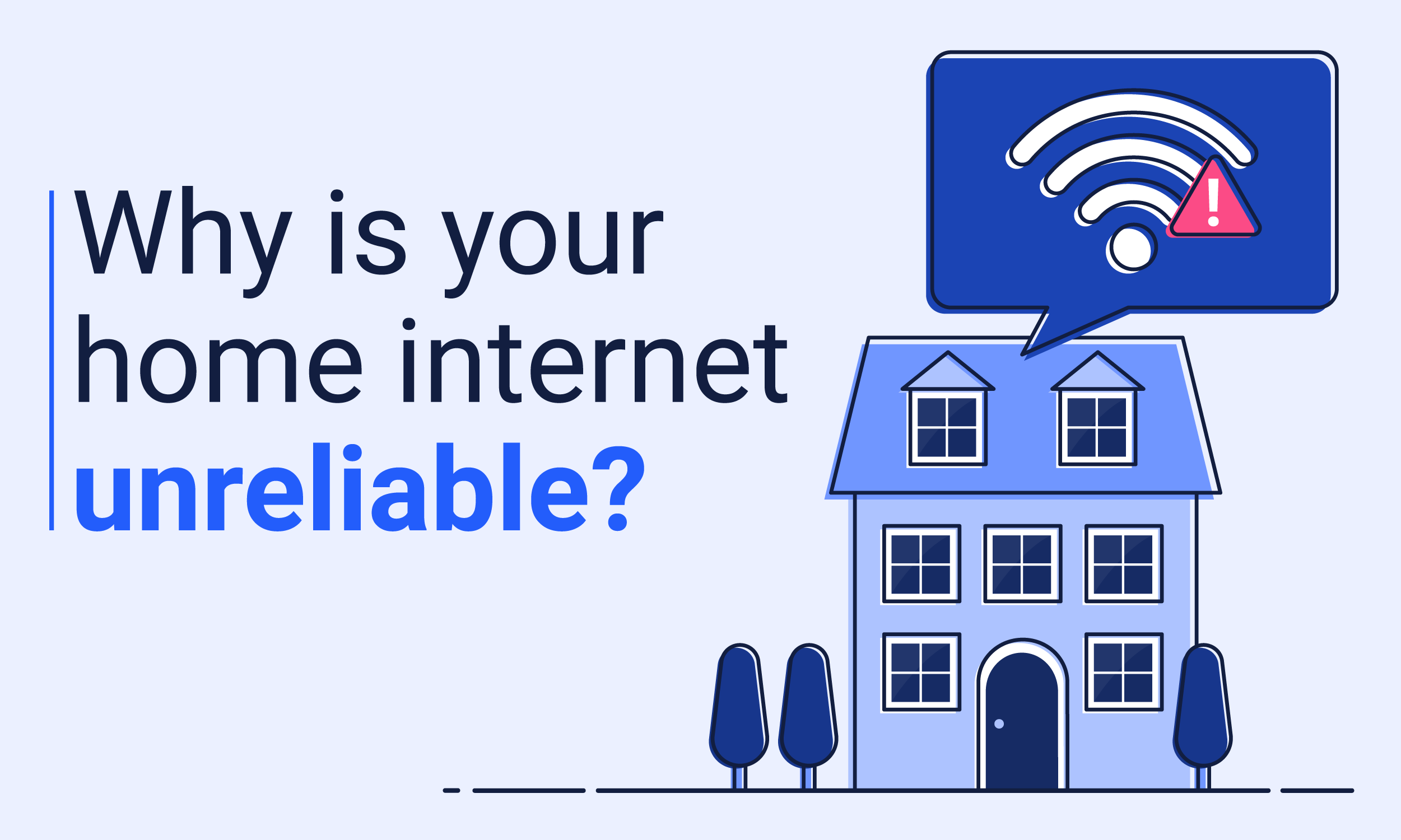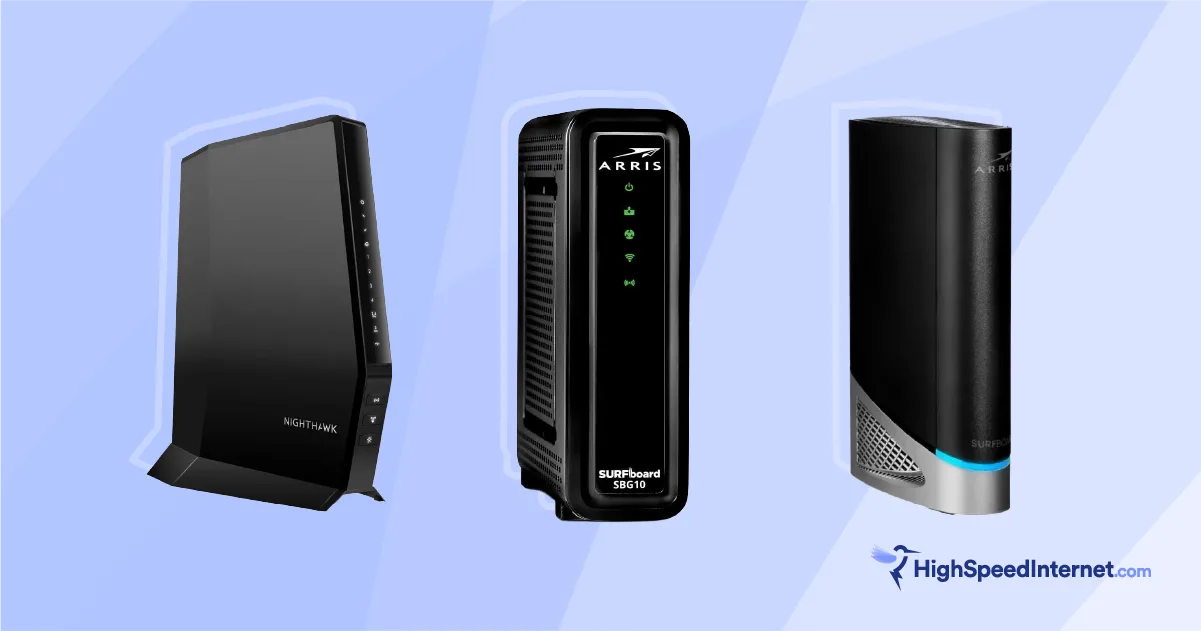6 Reasons Why Your Home Internet Is So Unreliable
Jun 24, 2021 | Share
FAQ, Featured

There’s never a good time for your internet to go out, especially when you work from home. A fast connection isn’t much good if it cuts out in the middle of an important meeting or brings the movie you’re watching to a grinding halt.
The source of your problems might be your home network or your internet service provider (ISP). We’ll look at some of the most common issues and what you can do about them.
Your router crashed
You might not think about it this way, but your router is just a specialized computer that has a processor and runs software in order to keep your network running. And, just like any computer, the software it’s running can crash, as can the entire device. There are countless reasons this can happen, from bugs in the software to the whole router overheating.
How to fix it
Fortunately, the immediate solution is very simple: turn it off and on again. This will reboot the system and all the software can start up again. The downside is that while power cycling the system like this will get your network up and running again, it doesn’t do anything to fix the problem that made your router crash in the first place.
If you find yourself restarting your router on a regular basis, you might have a more serious problem. The first step would be to log in to your router and update your firmware. If the problem continues, it might be time to buy a new router.
There are too many devices on your network
Even if your internet connection has enough speed for all the devices on your network, sometimes you can have more devices than your router can keep up with. It’s a bit like trying to manage a crowded restaurant. Even if there’s plenty of food coming out of the kitchen, it’s going to be hard keeping all the tables happy if you have only one server.
If you have an older router, it will communicate with your devices one at a time. It might send a chunk of video data to your TV, send a notification to your cell phone, send part of a software update to your office computer, and then finally send the next chunk of video to your TV. If you have too many devices on your network, it might not get the next chunk of video to your TV in time to keep the show playing smoothly.
Modern routers make use of multi-user, multiple input, multiple output (MU-MIMO) technology. This allows the router to send data to more than one device at a time so that it can manage network traffic more efficiently. Wi-Fi 6 routers have even greater MU-MIMO capacity, as well as several other technologies to help manage multiple devices.
How to fix it
If your router’s relatively new and supports MU-MIMO, you probably don’t have enough devices that you need to rush out and upgrade to Wi-Fi 6. If, however, you have an older router and a ton of smart devices, upgrading to a Wi-Fi 6 router might give you a more reliable connection.
There’s internet congestion in your area
If you have cable internet, you might notice your connection gets slow or inconsistent at the same time every day. This is because bandwidth on cable connections is actually shared among several homes in the same neighborhood, causing congestion at peak hours.
How to fix it
The easiest way to deal with this problem is to avoid doing bandwidth-intensive activities, like streaming video at peak hours in the evening. Of course, the reason that there’s congestion in the first place is because it’s a time when you probably want to be relaxing and watching a movie.
The more permanent solution is to switch to an internet provider that uses a different technology, like fiber.
Want to see what other providers are available in your area? Enter your zip code below.
You have high latency
If your connection does just fine streaming Netflix but suddenly develops issues when you’re on a Zoom call or playing games online, you might have high latency.
Latency measures the time it takes for a signal to go from your computer to its destination and back. If this delay is too long, it can cause problems for real-time activities like video chat and multiplayer games.
To find out if you have high latency, the first step is to take a speed test. This will show your upload and download speed, as well as your latency. A good latency measurement is one that falls between 50 ms and 100 ms. Latency that’s higher than 150 ms can cause major disruptions like lag, dropped calls, and losing your connection to game servers.
How to fix it
There are lots of ways to reduce latency on your home network, but the easiest way is to plug the device you’re using in to your router using an Ethernet cable.
Your connection is being throttled
If you notice that your connection gets slow or inconsistent at the end of every month, your connection might be throttled for passing your monthly data cap. Many internet plans (including some that advertise “unlimited data”) have limits for the amount of data you can use in a single month. If you pass these limits before the next month starts, you could be charged extra fees or have your speed dramatically reduced.
How to fix it
If you pass your data cap consistently every month, it might be worth upgrading to a plan with a higher data allowance. You could also switch to an internet provider without data caps. Just sayin’.
Your provider’s network is down
Sometimes the problem isn’t on your end at all. Providers can have all or part of their network go down due to natural disasters and severe weather or just the normal wear and tear on older systems. These unplanned outages are most common in older wired technologies like DSL and less common in technologies like fiber.
ISPs also have to take down part of their network on purpose to perform maintenance. Again, less reliable technologies like DSL require more maintenance. With planned downtime, ISPs can usually keep your connection from going out completely, but you might notice the drop in speed.
How to fix it
If you suspect that your ISP’s network is down, most have an outage tracker somewhere on their website. You can also call your ISP’s customer service to report an outage and get an estimate of when your service will be up again.
If all else fails…
If you’ve tried everything and you still have an unreliable internet connection, it might be worth it to switch to a different provider. When choosing a replacement, be sure to prioritize factors like reliability as well as speed. Some connection types, like fiber, are inherently more reliable. You can also get an idea of how reliable an ISP’s network is by reading customer reviews or checking out its reliability score on our customer satisfaction survey.
Find reliable internet plans in your area. Enter your zip code below.
Author - Peter Christiansen
Peter Christiansen writes about telecom policy, communications infrastructure, satellite internet, and rural connectivity for HighSpeedInternet.com. Peter holds a PhD in communication from the University of Utah and has been working in tech for over 15 years as a computer programmer, game developer, filmmaker, and writer. His writing has been praised by outlets like Wired, Digital Humanities Now, and the New Statesman.
Editor - Cara Haynes
Cara Haynes has been editing and writing in the digital space for seven years, and she's edited all things internet for HighSpeedInternet.com for five years. She graduated with a BA in English and a minor in editing from Brigham Young University. When she's not editing, she makes tech accessible through her freelance writing for brands like Pluralsight. She believes no one should feel lost in internet land and that a good internet connection significantly extends your life span.




